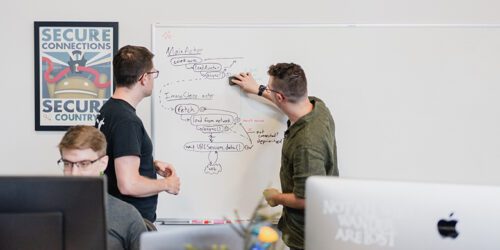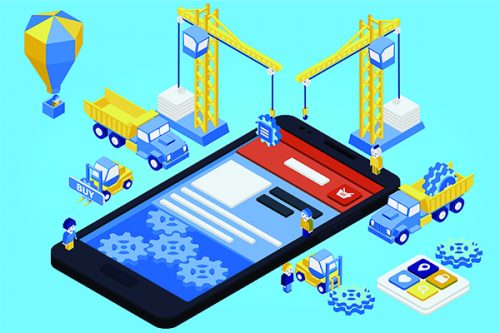
Don’t Eliminate Human Work. Enable It.
Digital Product Development LeadershipCompanies should focus on enabling human work through technology rather than on eliminating human work.
In this series, we have looked at what it takes to build a great Engineering Team. This post is going to be a little different as we chat with Angie Terrell to get some of her thoughts on the topics shared thus far. Angie is the director of the Design team at Big Nerd Ranch, where she is also a Design Bootcamp instructor. Angie has been leading the Design team for over three years now and continues to push Big Nerd Ranch to excellence in all of the disciplines of Design for Digital Product Development.
In Part One, we talked about how the first step in building a great team is starting with yourself as a leader. Can you share some insights on how you lead yourself? What are some daily rhythms or disciplines that help you as a leader stay sharp, balanced and ready to lead?
Knowing yourself is key to being a leader. This means knowing things like your values, your strengths, your weaknesses, and your expectations.
It’s very difficult, if not impossible, to try to lead a team while trying to become someone you are not or attempting to embody values that you don’t believe in. If you think that others need you to be someone you are not, this will create an inherent tension and it simply does not work.
Also on a daily basis, I try to tune into when I’m not my best, either because of stress or not sticking to a regular schedule. On those days, I just have to be honest with myself and perhaps delegate more or set the sails down for a bit.
So how do I really come to authentically know myself? I meditate and I journal frequently. I would like to say I do this every day, but it’s more like 3-5 times a week depending on my schedule. No matter how frequently, it always helps me investigate what I feel, what I truly believe, what I can do, and what I cannot do. As a leader, it’s incredibly important to know what you should not do and what you cannot do. And then empower others to do those things.
In Part Two, we talked about building a team begins with who you currently have. Can you share from your experience what it is like to inherit a team? How did you navigate that season, build relationships and set your current team members up for success?
When you inherit a team, you are getting people that worked for the previous leader. The team was picked and shaped by that leader. That leader may not resemble you at all. So the first thing you need to do is assess the team’s expectations, their desires, and their goals. Learn as much as you can about the people individually and how the team functions together. For the first month or two, you should be observing, inquiring, and learning as much as you can. All the while, you can be shaping your vision for the team.
At some point, you need to assess whether the individuals on your team are aligned with your vision. It’s normal to find that someone doesn’t exactly fit with your vision or is performing in such a way that does not meet your expectations. It’s a good idea to have a frank conversation with that person as soon as you’ve been able to articulate your vision clearly and expectations clearly.
In Part Three our focus was on Hiring, building your team from the outside. What stories can you share from your experience on hiring Designers, any systems you use and advise you may have for others who are in this hiring season as a leader?
Determining skills are the first gateway by which a prospect will get an interview. Depending on the level of Designer we are looking for (Junior, Mid, Senior), there is a baseline of skills that one must have to qualify. That is mainly determined by someone’s portfolio. A polished, professional portfolio is essential to even get in the door.
After skills, communication is essential for a Designer at Big Nerd Ranch. In my experience, the ability to effectively communicate determines whether you succeed as a designer or not. So much of our job requires communication – communicating designs, understanding and inquiring into features, interviewing users, and so forth. It is much harder for me to teach effective communication than technical design skills. So if someone is lacking in one area, let’s say, user testing, yet they are an effective communicator, I will pick them any day. What makes someone an effective communicator? That could be an entire blog post of its own. But I look for someone who listens well and asks good questions.
Finally, in Part Four we spent some time exploring the idea of retention and it is not just important to build a great team but you also have to retain it. As a leader, this is something we focus on all of the time so can you share a little bit of how you create an environment where your team members want to stick around? What are some things that leaders can begin doing today that will ensure the future is one their team wants to be a part of?
It’s important that your team connect on things that are not necessarily work-related. Our team frequently shares articles or designs we like, things that make us laugh. We go to lunch together. When we’re in the office together, we spend time just laughing or talking. In the Design area at BNR, we created a space for our team that is comfortable and cozy, where we can gather together or just sit on the couch with our laptops. Most of the designers had a hand in rearranging our area, so they feel that it is theirs. The team genuinely likes each other.
As for my direct involvement with each individual, I have weekly 1:1s and we do bi-annual reviews. I am constantly aware of how they might want to grow in their career and what they want to learn. I try my best to provide any opportunity for that learning and growth.
As we wrap on our series, I hope this has been helpful as we think about building our teams. I want to thank Chris and Angie for their help in this article and partnership in leading the Engineering and Design teams at Big Nerd Ranch.

Companies should focus on enabling human work through technology rather than on eliminating human work.

It’s not a secret that consumers are looking at their relationships with companies differently than before. Customers are expecting more from companies they work...

Digital product development and app development are the same thing with a different name, right? Well, not exactly. Check out our blog to get...
